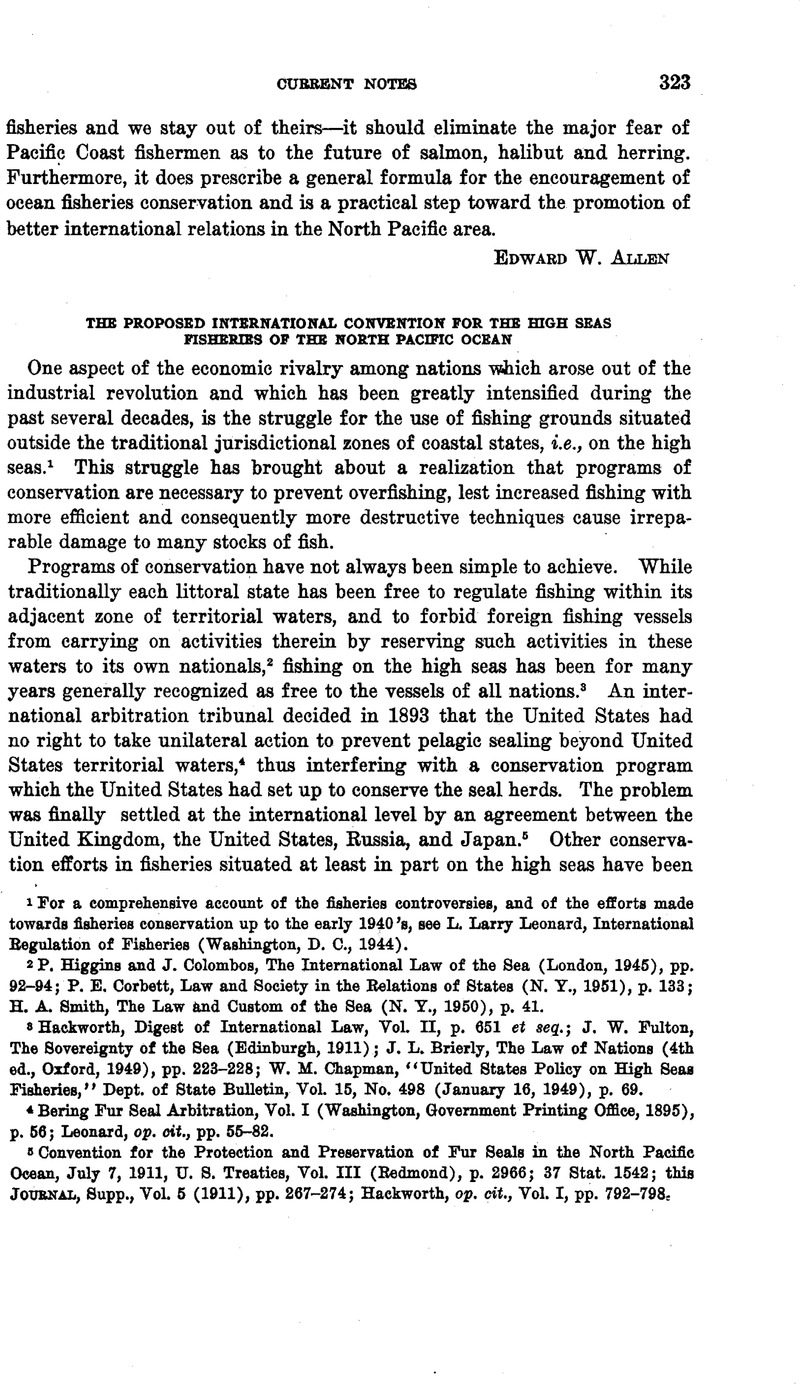No CrossRef data available.
Published online by Cambridge University Press: 20 April 2017

1 For a comprehensive account of the fisheries controversies, and of the efforts made towards fisheries conservation up to the early 1940’s, see Larry Leonard, L., International Begulation of Fisheries (Washington, D. C., 1944).Google Scholar
2 Higgins, P. and Colombos, J., The International Law of the Sea (London, 1945), pp. 92–94 Google Scholar; Corbett, P. E., Law and Society in the Relations of States (N. T., 1951), p. 133 Google Scholar; Smith, H. A., The Law and Custom of the Sea (N. T., 1950), p. 41 Google Scholar.
3 Hackworth, Digest of International Law, Vol. II, p. 651 et seq.; Fulton, J. W., The Sovereignty of the Sea (Edinburgh, 1911)Google Scholar; Brierly, J. L., The Law of Nations (4th ed., Oxford, 1949), pp. 223–228 Google Scholar; Chapman, W. M., “United States Policy on High Seas Fisheries,” Dept. of State Bulletin, Vol. 15, No. 498 (January 16, 1949), p. 69.Google Scholar
4 Bering Fur Seal Arbitration, Vol. I (Washington, Government Printing Office, 1895), p. 56; Leonard, op. cit., pp. 55–82.
5 Convention for the Protection and Preservation of Fur Seals in the North Pacific Ocean, July 7, 1911, U. S. Treaties, Vol. III (Redmond), p. 2966; 37 Stat. 1542; this Journal, Supp., Vol. 5 (1911), pp. 267–274; Hackworth, op. cit., Vol. I, pp. 792–798.
6 See Leonard, op. cit., pp. 98–109; Hayden, S. S., The International Protection of Wild Life (N. T., 1942)Google Scholar; Tomasevich, J., International Agreements on Conservation of Marine Resourees (Stanford, 1943)Google Scholar; Gregory, H. E. and Barnes, K., North Pacific Fisheries (N. T., 1939)Google Scholar; and Daggett, A. P., “The Regulation of Maritime Fisheries by Treaty,” this Journal, Vol. 28 (1934), p. 693 Google Scholar.
7 “The International Convention for the Northwest Atlantic Fisheries,” Dept. of State Bulletin, Vol. 15, No. 506 (March 13, 1949), p. 319 Google Scholar; Selak, C. B. Jr., “Recent Developments in High Seas Fisheries Jurisdiction under the Presidential Proclamation of 1945,” this Journal, Vol. 44 (1950), p. 670 Google Scholar; Castleman, Edward, “International Commission for Northwest Atlantic Fisheries,” Dept. of State Bulletin, Vol. 24, No. 623 (June 11, 1951), p. 954.Google Scholar
8 The U. S.-Mexico Tuna Convention, and the U.S.-Costa Rica Tropical Tuna Comvention. See Selak, loc. cit., p. 676.
9 Leonard, op. cit.
10 Allen, E. W., “The Fisheries Proclamation of 1945,” this Journal, Vol. 45 (1951), p. 177 Google Scholar; W. W. Bishop, Jr., “The Need for a Japanese Fisheries Agreement,” ibid., p. 712.
11 Leonard, op. cit., pp. 1–5, 127–136; Bingham, J. W., Report on the International Law of Pacific Coastal Fisheries (Stanford, 1938)Google Scholar; A Bill to assert the jurisdiction of the U. S. over certain portions of the Bering Sea and the submerged lands thereunder, S. 3744, 75th Cong., 3d Bess. (The Copeland Bill); A Bill to protect and preserve the salmon fishery of Alaska …, H. R. 8344, 75th Cong., 3d Sess. (The Dimond Bill). The former bill was based upon the “scientific fact” that the continental shelf off Alaska appertained to the U. S. and could properly be regulated thereby, while the latter declared that the salmon, having their breeding grounds in U. S. internal waters (i.e., Alaskan rivers and lakes) were the property of the U. S.; Jessup, P. C., “The Pacific Coast Fisheries,” this Journal, Vol. 33 (1939), p. 129 Google Scholar.
12 U. S. Dept. of State, Press Releases, Vol. 18 (Jan.-June, 1938), pp. 412–417.
13 Ibid., pp. 414, 416–417.
14 Leonard, op. cit., p. 5.
15 Dept. of State Bulletin, Vol. 14, No. 348 (March 3, 1946), pp. 346–347.
16 Ibid., Vol. 24, No. 608 (Feb. 26, 1951), p. 351; W. W. Bishop, Jr., loc. cit., p. 713. Italics added.
17 Dept. of State Bulletin, Vol. 25, No. 635 (Aug. 27, 1951), p. 350; Dept. of State Publication No. 4330 (August, 1951).
18 Art. V of the Proposed International Convention for the High Seas Fisheries of the North Pacific Ocean, hereinafter termed “the convention.” For text of convention, see Dept. of State Bulletin, Vol. 26, No. 662 (March 3, 1952), pp. 343–346; for a discussion of the background of the Tripartite Fisheries Conference, see William C. Herrington, “Problems Affecting North Pacific Fisheries,” ibid., pp. 340–342.
19 The Preamble begins: “The Governments of Canada, Japan and the United States of America … Acting as sovereign nations in the light of their rights under the principles of international law and custom to exploit the fishery resources of the high seas. …”
20 Convention, Art. I. Territorial waters are not defined, and Art. I (2) reads: “Nothing in this Convention shall be deemed to affect adversely (prejudice) the claims of any Contracting Party in regard to the limits of territorial waters or to the jurisdiction of a coastal state over fisheries.” This formula follows Art. I (2) of the Northwest Atlantic Convention of Feb. 8, 1949, and Art. III of the London Overfishing Convention of April 5, 1946. See Selak, loc. cit., p. 678.
21 The International North Pacific Fisheries Commission, so named by Art. II (1).
22 Convention Preamble and Art. II.
23 Art. II (3).
24 Art. III (1), (e), (ii).
25 Art. II (9).
26 Annex to the Convention, part 2.
27 Ibid., part 1.
28 Art. III (1), (a).
29 Art. III (1), (b) ; Art. IV (1), (b).
30 Art. IV.
31 Art. VII.
32 Art. IX.
33 Art. X.
34 Art. VI.
35 Art. XI.
36 Protocol to the Proposed International Convention for the High Seas Fisheries of the North Pacific Ocean.
37 Summary Record of Proceedings of the Committee on Principles and Drafting, Evening Sess., Dec. 13, 1951, p. 2; Japanese Foreign Ministry document entitled “Tripartite Fisheries Conference,” p. 102.
38 See above, p. 327.